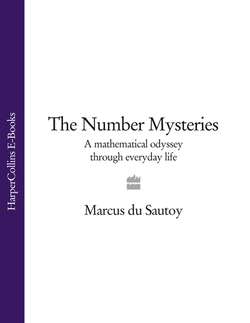Читать книгу The Number Mysteries: A Mathematical Odyssey through Everyday Life - Marcus Sautoy du - Страница 26
What are the odds that your telephone number is prime?
ОглавлениеOne of the geeky things that mathematicians always do is to check their telephone number to see whether it is prime. I moved house recently and needed to change my telephone number. I hadn’t had a prime telephone number at my previous house (house number 53, a prime) so I was hoping that at my new house (number 1, an ex-prime) I might be luckier.
The first number the phone company gave me looked promising, but when I put it into my computer and tested it I found that it was divisible by 7. ‘I’m not sure I’m going to remember that number … any chance of another number?’ The next number was also not prime—it was divisible by 3. (An easy test to see whether your number is divisible by 3: add up all the digits of your telephone number, and if the number you get is divisible by 3 then so is the original number.) After about three more attempts, the exasperated telephone company employee snapped: ‘Sir, I’m afraid I’m just going to give you the next number that comes up.’ Alas, I now have an even telephone number, of all things!
So what were the chances of me getting a prime telephone number? My number has eight digits. There is approximately a 1 in 17 chance that an eight-digit number is prime, but how does that probability change as the number of digits increases? For example, there are 25 primes under 100, which means that a number with two or fewer digits has a 1 in 4 chance of being prime. On average, as you count from 1 to 100 you get a prime every four numbers. But primes get rarer the higher you count.
The table below shows the changes in probability:
Primes get rarer and rarer, but they get rarer in a very regular way. Every time I add a digit, the probability decreases by about the same amount, 2.3, each time. The first person to notice this was a fifteen-year-old boy. His name was Carl Friedrich Gauss (1777–1855), and he would go on to become one of the greatest names in mathematics.
TABLE 1.2
Gauss made his discovery after being given a book of mathematical tables for his birthday which contained in the back a table of prime numbers. He was so obsessed with these numbers that he spent the rest of his life adding more and more figures to the tables in his spare time. Gauss was an experimental mathematician who liked to play around with data, and he believed that the way the primes thinned out would carry on in this uniform way however far you counted through the universe of numbers.
But how can you be sure that something strange won’t suddenly happen when you hit 100-digit numbers, or 1,000,000-digit numbers? Would the probability still be the same as adding on 2.3 for each new digit, or could the probabilities suddenly start behaving totally differently? Gauss believed that the pattern would always be there, but it took until 1896 for him to be vindicated. Two mathematicians, Jacques Hadamard and Charles de la Vallée Poussin, independently proved what is now called the prime number theorem: that the primes will always thin out in this uniform way.
Gauss’s discovery has led to a very powerful model which helps to predict a lot about the behaviour of prime numbers. It’s as if, to choose the primes, nature used a set of prime number dice with all sides blank except for one with a PRIME written on it:
FIGURE 1.25 Nature’s prime number dice.
To decide whether each number is going to be prime, roll the dice. If it lands prime side up, then mark that number as prime; if it’s blank side up, the number isn’t prime. Of course, this is just a heuristic model—you can’t make 100 indivisible just by a roll of the dice. But it will give a set of numbers whose distribution is believed to be very like that of the primes. Gauss’s prime number theorem tells us how many sides there are on the dice. So for three-digit numbers, use a six-sided dice or a cube with one side prime. For four-digit numbers, an eight-sided dice—an octahedron. For five, digits a dice with 10.4 sides … of course, these are theoretical dice because there isn’t a polyhedron with 10.4 sides.
